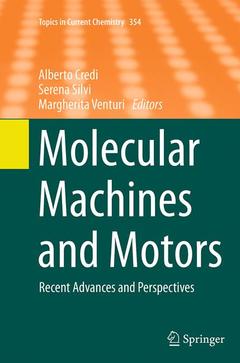Description
Molecular Machines and Motors, 2014
Recent Advances and Perspectives
Topics in Current Chemistry Series, Vol. 354
Coordinators: Credi Alberto, Silvi Serena, Venturi Margherita
Language: English
Subjects for Molecular Machines and Motors:
Molecular Machines and Motors
Publication date: 08-2016
Support: Print on demand
Publication date: 08-2016
Support: Print on demand
Molecular Machines and Motors. Recent Advances and Perspectives
Publication date: 09-2014
342 p. · 15.5x23.5 cm · Hardback
Publication date: 09-2014
342 p. · 15.5x23.5 cm · Hardback
Description
/li>Comment
/li>
The cutting-edge advances in this research field are nicely pictured in the chapters of this volume. They come from world?s leading laboratories engaged in the development of molecular machines and are authored by some of the most respected scientists in the field. This volume shows, on the one hand, the level of ingenuity and technical capability reached in the construction of artificial nanomachines roughly two decades after their inception. On the other hand, it conveys the excitement about the enormous opportunities as well as the challenges this research area presents, as the interest of researchers is shifting from ensemble to single-molecule measurements and from homogeneous to heterogeneous environments. Indeed, as Feynman said ?when we have some control of the arrangement of things on a molecular scale, we will get an enormously greater range of possible properties that substances can have.? Although the answer to the ?when? question is not easy to find, there is no doubt that artificial molecular machines and motors will lead to a wide variety of applications which we cannot even envisage today.
The goal of each thematic volume in this series is to give the non-specialist reader, whether in academia or industry, a comprehensive insight into an area where new research is emerging which is of interest to a larger scientific audience. Each review within the volume critically surveys one aspect of that topic and places it within the context of the volume as a whole. The most significant developments of the last 5 to 10 years are presented using selected examples to illustrate the principles discussed. The coverage is not intended to be an exhaustive summary of the field or include large quantities of data, but should rather be conceptual, concentrating on the methodological thinking that will allow the non-specialist reader to understand the information presented. Contributions also offer an outlook on potential future developments in the field. Review articles for the individual volumes are invited by the volume editors. Readership: research chemists at universities or in industry, graduate students.The Nobel Prize in Chemistry 2016 was awarded jointly to Jean-Pierre Sauvage, Sir J. Fraser Stoddart and Bernard L. Feringa "for the design and synthesis of molecular machines".
Both Jean-Pierre Sauvage and Bernard L. Feringa contributed to this volume.
This series presents critical reviews of the present position and future trends in modern chemical research Short and concise reports on chemistry, each written by the world renowned experts Still valid and useful after 5 or 10 years More information as well as the electronic version of the whole content available at: springerlink.com
© 2024 LAVOISIER S.A.S.



